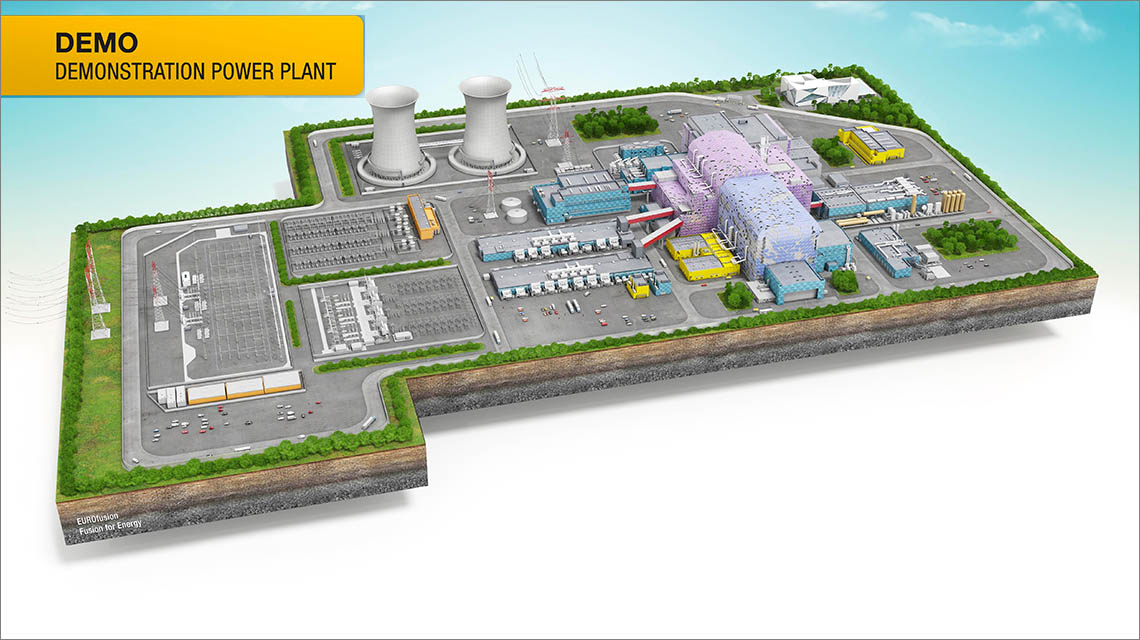Italian National Agency for New Technologies, Energy and Sustainable Economic Development

Energy: The design of the first fusion power plant up to 500 MW is under way
DEMO (Demonstration Fusion Power Reactor) will start operations around mid-century. This was announced by the EUROfusion Consortium, which includes 21 Italian organisations coordinated by ENEA, including CNR-Istp and the RFX Consortium
The engineering design of the first fusion demonstration power plant capable of safely and sustainably producing 300-500 MW of electrical power around mid-century has begun. Called DEMO (Demonstration Fusion Power Reactor), the plant will be able to meet the annual needs of around 1.5 million households.[1] This was announced in Brussels by the EUROfusion Consortium – comprising 21 Italian organisations coordinated by ENEA, including the Institute for Plasma Science and Technology of the National Research Council (CNR-Istp) and the RFX Consortium – at the launch conference of Horizon EUROfusion, the new European fusion research programme co-funded by the European Commission through Euratom.
The DEMO demonstration reactor will be the successor to the ITER experimental plant currently under construction in the south of France, in Cadarache.
“This is an important step that will move fusion research from a purely experimental sphere to the actual production of electricity. To do so, DEMO will have to implement the most advanced technologies to ‘control’ the plasma and generate electricity safely and continuously by operating with a closed fuel cycle”, stressed Alessandro Dodaro, director of ENEA's Department of Fusion and Nuclear Safety Technologies. “To this end, with our partners we are building the Divertor Tokamak Test (DTT) super laboratory at the Frascati Research Centre. Here we will test various new configurations and materials for the divertor, the device that will be responsible for dissipating residual heat inside the fusion reactors with power flows exceeding 10 million watts per square metre, comparable to those on the surface of the Sun”, added Dodaro.
“This step confirms the European roadmap for the production of electricity from fusion reactions”, explained Daniela Farina, director of the Institute for Plasma Science and Technology at CNR. “In order to successfully achieve this goal, the research community must actively pursue the scientific and technological issues that are still open with the broadest possible perspective, which CNR is working on in synergy with other Italian bodies and institutions as part of an extraordinary worldwide collaboration. It’s a global effort that cannot be sustained without strong support over the long term”.
“The decision to develop the DEMO project, a demonstration fusion reactor in Europe, was the natural development of Europe’s ongoing commitment – having always been a global leader in this area – to promoting research into energy resources with a low environmental impact, hydrogen fusion being one of the ingredients in the basket of renewable and eco-sustainable sources”, pointed out Piergiorgio Sonato, president of the RFX Consortium, whose members are CNR, ENEA, INFN, the University of Padua and Acciaierie Venete. “In the CNR Research Area in Padua, in addition to the RFX-mod experiment, which is one of the high priority research infrastructures as defined in the 2021-2027 PNIR (National Plan of Italian Research Infrastructures), the RFX Consortium hosts the neutral particle injector development laboratory for ITER, the NBTF (Neutral Beam Test Facility). This is the indispensable element required for igniting and controlling the hydrogen fusion reaction in the ITER reactor being installed in Cadarache, France, and which China, South Korea, India, Japan, Russia, the United States of America and the European Union are all contributing to”, Sonato added.
The announcement of DEMO comes on the heels of EUROfusion's record achievement at the JET (Joint European Torus) plant in Culham (UK), which produced 59 megajoules[2] of total fusion energy using the same deuterium-tritium (plasma) fuel mix that will be used in ITER, DEMO and future fusion power plants. The record was made possible by creating and sustaining stable plasmas capable of generating high values of fusion power, about 11 MW, for 5 seconds, against about 33 MW of heating power input from the outside.
The EUROfusionEUROfusion Consortium coordinates European research in the field of fusion energy in line with the EU roadmap. Its network comprises some 4,800 scientists from institutions in 29 states (26 EU members, Switzerland, the UK and Ukraine).
EUROfusion can count on funding of more than 1 billion euros for the years 2021-2025 (Second Grant), which includes a Euratom contribution of more than 550 million euros. Italy, the Consortium's second-most important partner after Germany, will receive 16% of the European contribution, amounting to approximately 90 million euros.
Thermonuclear fusion
Within the sun and stars, the fusion of hydrogen nuclei produces helium and releases energy, the radiation of which enables life on Earth. Scientists around the world are working to replicate similar reactions with hydrogen isotopes, which release enormous amounts of energy when they fuse. The aim of the research is to build nuclear fusion power plants for large-scale, safe, cost-competitive and environmentally friendly power generation. In terms of yield, for the same quantity, fusion will generate about four million times more energy than burning coal, oil or gas.
Link to the press kit https://surfdrive.surf.nl
